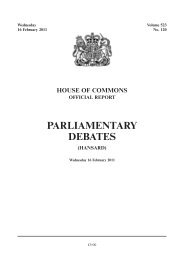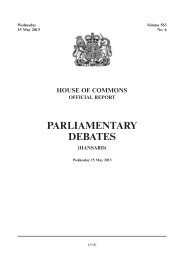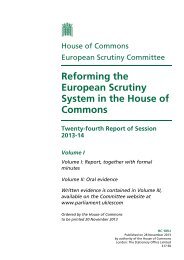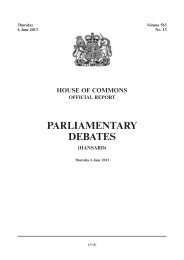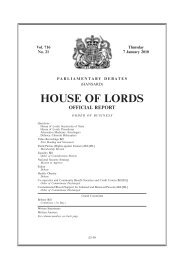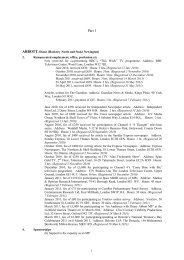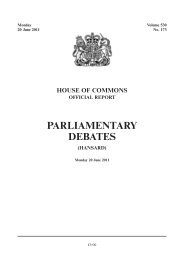Ticketing and Concessionary Travel on Public Transport - United ...
Ticketing and Concessionary Travel on Public Transport - United ...
Ticketing and Concessionary Travel on Public Transport - United ...
You also want an ePaper? Increase the reach of your titles
YUMPU automatically turns print PDFs into web optimized ePapers that Google loves.
Ev 68 <strong>Transport</strong> Committee: Evidence<br />
additi<strong>on</strong>al funds. It is therefore sensible for Network Rail to look bey<strong>on</strong>d the rail network <str<strong>on</strong>g>and</str<strong>on</strong>g> c<strong>on</strong>sider<br />
supporting all modes of surface <str<strong>on</strong>g>and</str<strong>on</strong>g> sub-surface public transport. With DfT policy now being to spread<br />
ITSO technology <strong>on</strong>to heavy rail, <str<strong>on</strong>g>and</str<strong>on</strong>g> the financial needs of ITSO Ltd, it makes sense to fold <strong>on</strong>e<br />
Membership Company (ITSO Ltd) into the other <strong>on</strong>e (Network Rail).<br />
18. The present commercial arrangements (with the competiti<strong>on</strong> problem menti<strong>on</strong>ed above, <str<strong>on</strong>g>and</str<strong>on</strong>g> the<br />
short termism still built into rail franchising) militate against significant investment by the service providers,<br />
<str<strong>on</strong>g>and</str<strong>on</strong>g> of course central government doesn’t want to fund large capital programmes. But there may be a light<br />
at the end of the tunnel as far as ticketing systems are c<strong>on</strong>cerned, although the tunnel appears to be currently<br />
blocked by DfT inacti<strong>on</strong>—hence the statement made by PSSG this week.<br />
19. It has recently become clear that there are two str<str<strong>on</strong>g>and</str<strong>on</strong>g>s being discussed <str<strong>on</strong>g>and</str<strong>on</strong>g> perhaps developed<br />
within DfT:<br />
— in a similar manner to the Scottish project 6 , roll out electr<strong>on</strong>ic ticketing over all 50,000 service<br />
buses in the UK (the public sector to use the functi<strong>on</strong>ality to manage c<strong>on</strong>cessi<strong>on</strong>ary travel); <str<strong>on</strong>g>and</str<strong>on</strong>g><br />
— roll out electr<strong>on</strong>ic ticketing right across heavy rail (perhaps 25,000 items of ticketing equipment).<br />
20. But there is no co-ordinated acti<strong>on</strong>, <str<strong>on</strong>g>and</str<strong>on</strong>g>, at the March 19th Supplier Briefing sessi<strong>on</strong> for the DfT<br />
procurement of services for <str<strong>on</strong>g>C<strong>on</strong>cessi<strong>on</strong>ary</str<strong>on</strong>g> Bus <str<strong>on</strong>g>Travel</str<strong>on</strong>g>, there was a clear statement that there is no DfT<br />
policy to roll out ITSO technology across all of surface <str<strong>on</strong>g>and</str<strong>on</strong>g> sub-surface public transport in Engl<str<strong>on</strong>g>and</str<strong>on</strong>g>.<br />
21. The probable timescale is five years, ie roll out to be completed by 2012. If that is coupled with<br />
eVective <strong>on</strong>-line ticket purchasing across the internet 7 , it should be possible to leverage a large proporti<strong>on</strong><br />
of the capital investment out of the private sector—that is because with multi-modal deployment there will<br />
be a l<strong>on</strong>g term future for the methods. I believe that Eric Samps<strong>on</strong> was right when he said to me that the<br />
big service operators have to get to the stage where they all decide to move together <str<strong>on</strong>g>and</str<strong>on</strong>g> authorise the<br />
investment in interoperable electr<strong>on</strong>ic ticketing. Currently I believe that n<strong>on</strong>e of the major operating groups<br />
has a positive business plan for the rollout <strong>on</strong> their own: they see costs but not enough financial benefit 8 ,<br />
but they will invest if they see a nati<strong>on</strong>al policy announced <str<strong>on</strong>g>and</str<strong>on</strong>g> taken forward. DfT has to show us a coordinated<br />
five year project if integrated ticketing is to be delivered, <str<strong>on</strong>g>and</str<strong>on</strong>g> DfT has to manage the programme<br />
far better than hitherto.<br />
22. It should be noted that the ticketing envir<strong>on</strong>ment resulting from a nati<strong>on</strong>wide rollout will not just be<br />
a rollout of smart cards. Other physical formats of smart media will be used, as will (with care) print at home<br />
(using bar codes for security) <str<strong>on</strong>g>and</str<strong>on</strong>g> “show <str<strong>on</strong>g>and</str<strong>on</strong>g> go” ticket to mobile ph<strong>on</strong>e. New secure short range technology<br />
is coming al<strong>on</strong>g (Near Field Communicati<strong>on</strong> is currently the best suggesti<strong>on</strong>, embedded in mobile ph<strong>on</strong>es),<br />
<str<strong>on</strong>g>and</str<strong>on</strong>g> could fit <strong>on</strong>to the fr<strong>on</strong>t end of ITSO style schemes. The ITSO Method is capable of adaptati<strong>on</strong> to these<br />
diVerent ticketing media, although currently a very rigid DfT m<str<strong>on</strong>g>and</str<strong>on</strong>g>ate for “all cards to be usable<br />
everywhere” 9 is inhibiting, <str<strong>on</strong>g>and</str<strong>on</strong>g> there is no credible way for extensi<strong>on</strong>s to be managed.<br />
The Use of Smartcard Technologies<br />
3. Is the industry taking up modern smartcard technologies adequately <str<strong>on</strong>g>and</str<strong>on</strong>g> appropriately?<br />
23. No, but why should it? “Industry” in the shape of the set of public transport operators has an<br />
overwhelming duty to its shareholders, <str<strong>on</strong>g>and</str<strong>on</strong>g> until recently there have been indicati<strong>on</strong>s that they see<br />
introducti<strong>on</strong> of the technology as having a massively negative business case for them unless about £250M<br />
is pumped in by government. Also, in the absence of measures to promote growth in public transport, the<br />
necessary parallel introducti<strong>on</strong> of interoperable ticketing has a negative business case to a service operator,<br />
because it increases competiti<strong>on</strong>. But now I believe that they see the benefits of improved service<br />
management that the ITSO Envir<strong>on</strong>ment delivers, plus a determinati<strong>on</strong> within government to improve<br />
public transport services.<br />
24. The answer to this <strong>on</strong>e is already presaged in the answer to Q2: we need:<br />
— a co-ordinated 5 year strategy <str<strong>on</strong>g>and</str<strong>on</strong>g> programme from DfT, designed to leverage most of the<br />
investment out of the private sector; <str<strong>on</strong>g>and</str<strong>on</strong>g><br />
— a change in the way that the technology is managed.<br />
6 But it must be managed much better than the Scottish project.<br />
7 Not using the clumsy method apparently currently being put forward—see later in this submissi<strong>on</strong>.<br />
8 About three years ago some<strong>on</strong>e from <strong>on</strong>e of the big transport service groups showed me his figures: they were looking for a<br />
grant as subsidy that, divided by the number of buses in their fleet, came out at £3,000 per bus—however, since then many<br />
of them have already invested in new ticket machines, so the per bus figure will now be lower. Get them to move together,<br />
justifying the capitalisati<strong>on</strong> of the funding, <str<strong>on</strong>g>and</str<strong>on</strong>g> they will do it themselves.<br />
9 Which has already been deviated from.



